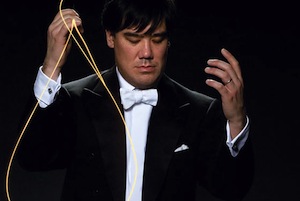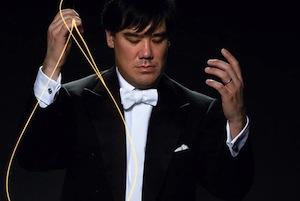The New York Philharmonic, due into Davies Symphony Hall on May 13 and 14, counts as the oldest continuous orchestra in the U.S.: It dates from 1842 (though previous iterations go all the way back to 1816). Yet, for all its maturity, the orchestra has often seemed like a dysfunctional family, with the players as fractious children.
Actually, squabbling parents may be a more apt metaphor. Past tales of players insulting their conductors during rehearsals (as happened to Otto Klemperer, with the principal oboist loudly complaining, “Klemps, you talka too much”) or goofing off during supposedly serious performances (as happened when Leonard Bernstein assayed John Cage’s Atlas Eclipticalis in 1964) may be a thing of the past.
But dysfunctionality is still much in evidence. After the halcyon years when Bernstein was music director (1958–1969), followed by Pierre Boulez (1971–1977), we have had an onslaught of Mehtas. First there was Zubin (1978–1991), flashy, good at Bruckner, but, by all evidence, often uninterested. Then came his brother, Zarin, as executive director (2000–2012).
In between there was the joint tenure of Kurt Masur as music director (1991–2002) and Deborah Borda as executive director (1999–2001). The two clashed, with Masur espousing a solid Germanic repertory (which he conducted well) but blamed by Borda and the players for his authoritarianism, while Borda yearned for the kind of frisky innovation she has put in place in Los Angeles.
To my taste, Zarin Mehta seemed cynical and unimaginative (“shrewd” and “honorably devoted to tradition” was probably the way he saw it). His choice of music director, Lorin Maazel (2002–2009), got the Philharmonic to play surpassingly well but inflected his interpretations with all manner of eccentric twists and turns. As Zubin Mehta was good with Bruckner, so Maazel shone in Strauss. But that was not enough.
Alan Gilbert: Where’s the Excitement?

Photo by Henry Leutwyler
Now we have Alan Gilbert, also courtesy of Zarin Mehta. Gilbert has had his earnest defenders, and he has a nice back story: His mother was, and is, in the orchestra. He has involved himself with local musical life, at the Juilliard School and the Metropolitan Opera. But he has failed to seize the imagination of many audience members or most critics. In 1940, Virgil Thomson famously ended his very first review as music critic of the New York Herald Tribune by quoting “a friend” saying, “I understand now why the Philharmonic is not part of New York’s intellectual life.” Except for flashes of relevance during the Bernstein and Boulez years, that remains true to this day — unlike the situations in San Francisco or in Los Angeles.
Gilbert’s main problems — aside from a lack of personal charisma, which may be a superficial standard of judgment but which still counts in our image-conscious modern world — seem to be two. First, his seasonal repertory is timid — standard, not to say predictable, not to say dull. His taste in contemporary music runs to the Euro-modern school, compared with Michael Tilson Thomas’ mavericks or Gustavo Dudamel’s Latinate eclecticism. Magnus Lindberg, Gilbert’s first composer in residence, can be interesting but is not exactly exciting to the Poisson Rouge crowd.
Lindberg’s second Piano Concerto is on the May 13 Davies Hall program, but the rest of the San Francisco repertory gives a decent snapshot of the week-in, week-out programming at Avery Fisher Hall: not bad music, but pretty conventional. Gilbert’s choice of soloists — in San Francisco, Yefim Bronfman and the veteran concertmaster Glenn Dicterow — are usually drawn from the same ever-recurrent Lincoln Center/Carnegie Hall pool. Even The New York Times, which has regularly defended Gilbert, has begun to complain about the repertory announced for the 2012–13 season.
At those regular repertory concerts I have heard, Gilbert led the music straightforwardly, with no special refinement or imagination or excitement.
The exceptions have been the annual big heaves that Gilbert unloads on eager critics and what lively audience there is for the Philharmonic. There have been ingeniously semistaged operas like Ligeti’sGrand macabre (still not seen in a full staging in provincial New York) and Janáček’s Cunning Little Vixen. This year’s offering (June 29–30) will be two identical concerts of “spatial music” that include Stockhausen’s Gruppen — tellingly, not produced by the Philharmonic alone but as a coproduction with the Park Avenue Armory, at the Armory.
The Challenges Ahead
Gilbert’s other problem is how he conducts standard repertory. Maybe history will look on Gilbert and Dudamel — to take the most immediate comparison — as the tortoise and the hare, with Dudamel running around frenetically and Gilbert plodding along until he achieves magisterial greatness. Maybe. To judge from some reviews and reports from friends, the orchestra’s spring European tour was well-received. The Philharmonic players, children no longer and honed by Maazel, can certainly play. But at those regular repertory concerts I have heard, Gilbert led the music straightforwardly, with no special refinement or imagination or excitement. People called Masur a kapellmeister, but Gilbert, while more benign, is more of one, at least on the basis of my limited encounters with his conducting. Even the big pieces, like the Janáček and the Ligeti, seemed solidly done but not riveting.
All it will take to restore the orchestra into New York’s intellectual life is imagination and bravery and, from the board, money.
So what will the New York Philharmonic’s new executive director, Matthew VanBesien, inherit? Apparently only chosen after at least six higher-profile candidates turned the Philharmonic down, VanBesien is an American who comes to New York after running the Houston and Melbourne (Australia) orchestras. He faces not only the Gilbert problem, if it is a problem, but also a conservative and likely dwindling audience. (Swaths of seats are routinely empty at Avery Fisher Hall, though now often filled with rush-ticket buyers. Mehta used to insist that all the concerts sold out, but that evasion could only be justified because a corporation paid for all unsold seats). On top of that, there is the endless dithering about yet another rebuilding of the Philharmonic’s hall, and the larger problem of its having to compete, week in and week out, with glamorous visiting orchestras in both Avery Fisher and Carnegie Halls.
VanBesien has, in short, a steep mountain to climb. The good news is that he has a lot of room to maneuver, since there is so much to improve. I wish him well: The Philharmonic can still play beautifully, and may well do so this month in San Francisco. While its history may be troubled, it’s also rich. All it will take to restore the orchestra into New York’s intellectual life is imagination and bravery and, from the board, money.

